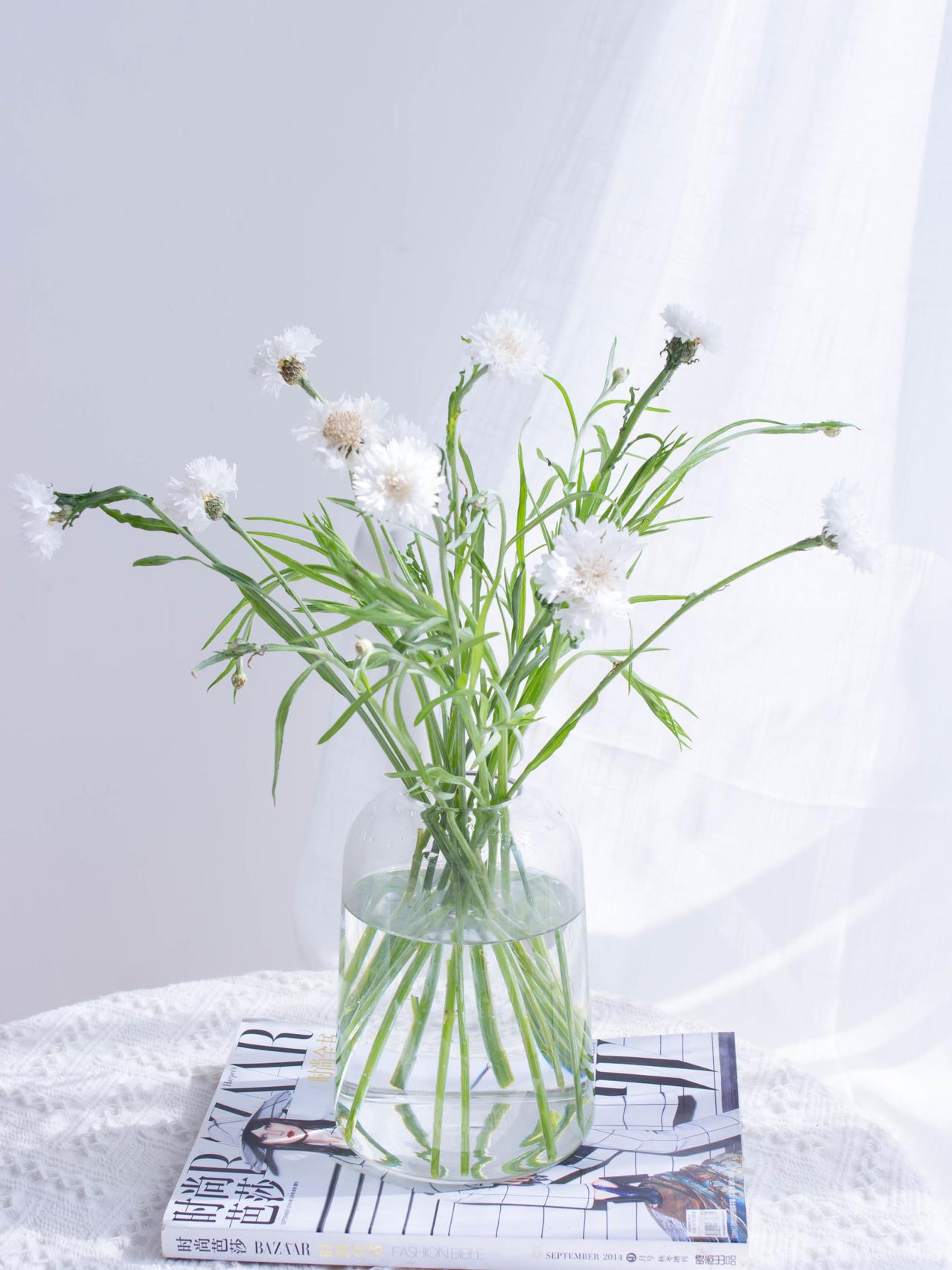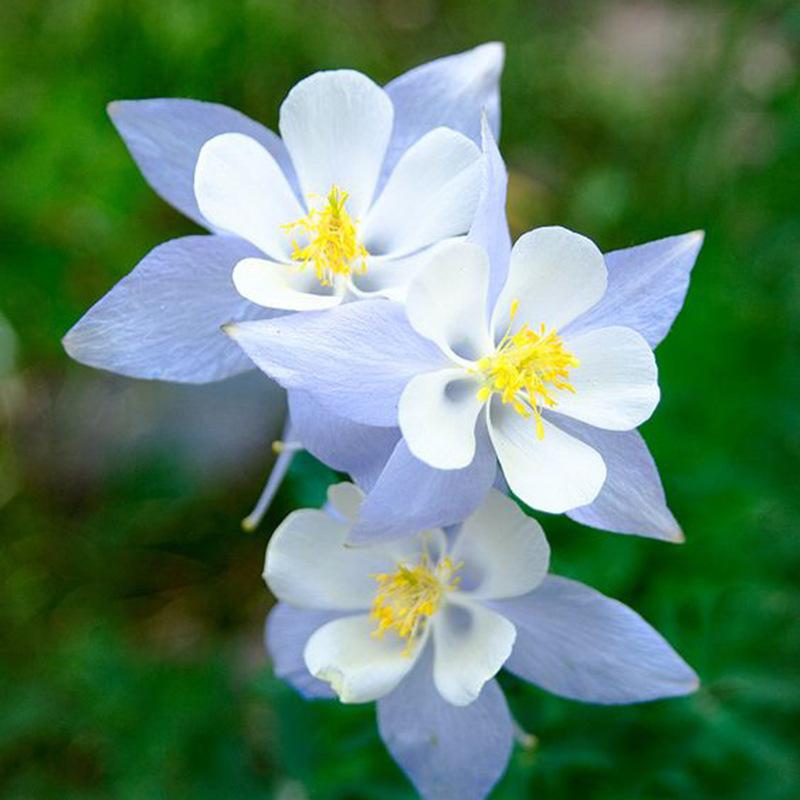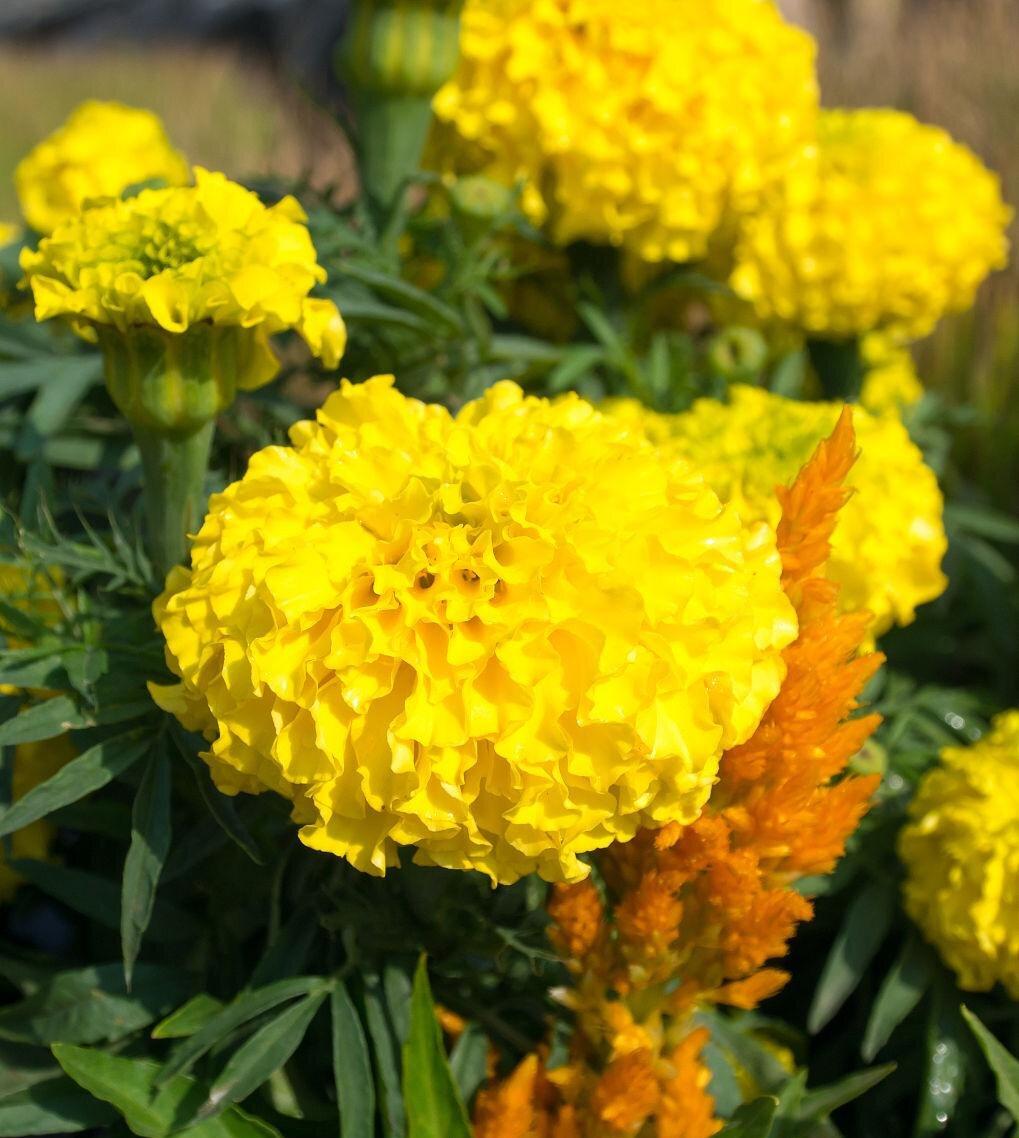The Hippeastrum, commonly known as the Amaryllis, has an intriguing story. Legend has it that the flower originated from a timid nymph named Amaryllis, who fell deeply in love with a bold shepherd Alteo. Determined to win Alteo’s heart, Amaryllis sought guidance from the Oracle, who advised her to pierce her heart with a golden arrow for 30 consecutive nights. As Amaryllis followed the Oracle’s instructions, each drop of blood that fell from her heart transformed into a splendid crimson flower. Alteo was captivated by the enchanting blooms, and their love blossomed, making the Hippeastrum a symbol of passion and devotion.
Picture
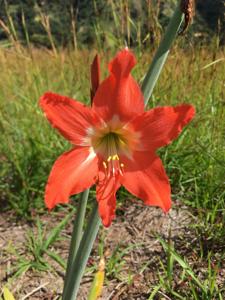
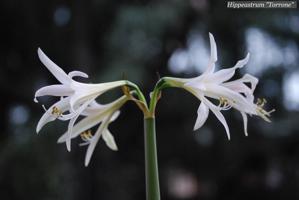
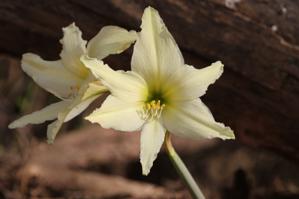
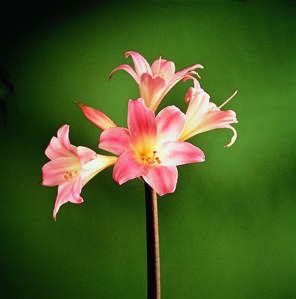
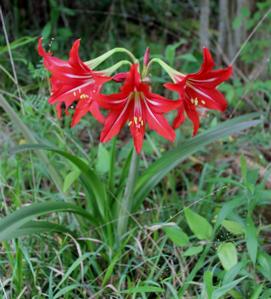
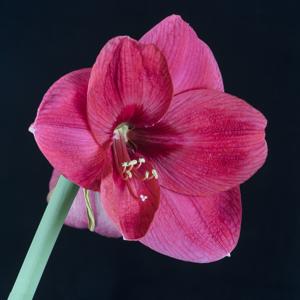
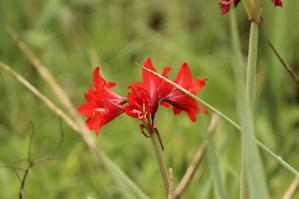
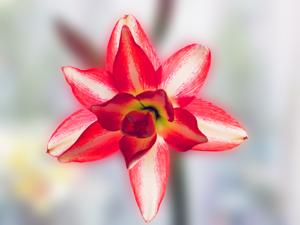
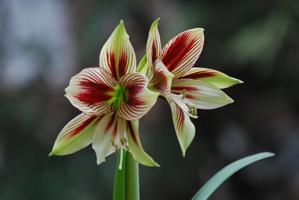
Plant some seeds now!
Short Description
Flower, leaves and bulb of Hippeastrum miniatum. Francisco Manuel Blanco, Flora de Filipinas 1880–1883
Hippeastrum bulb
Detail of Hippeastrum flower
Hippeastrum (/ˌhɪpiːˈæstrəm/) is a genus of about 90 species, and over 600 hybrids and cultivars, of perennial, herbaceous and bulbous plants, native to tropical and subtropical regions of the Americas, from Mexico south to Argentina and on some islands in the Caribbean. The majority have large, fleshy bulbs—usually about the size of a softball—and tall, broad, strap-like leaves that are (generally) evergreen, and large red or purple flowers. Numerous colors and cultivars have been created over the past hundred years.
Hippeastrum is a genus in the family Amaryllidaceae (subfamily Amaryllidoideae, tribe Hippeastreae, and subtribe Hippeastrinae). For many years, there has been confusion among botanists, as well as collectors and the general public, over the generic names Amaryllis and Hippeastrum; the former is a South African genus of plants, while the latter is a new world genus. However, the common name “amaryllis” has been used for Hippeastrum for years, especially for the ornamental cultivars (sold as indoor flowering bulbs around November and December, for Christmas, in the Northern Hemisphere). Within the genus Hippeastrum exist many epiphytic species, as well, which may be found living in natural debris and leaf litter on the crooks of tree branches; by comparison, Amaryllis is a primarily terrestrial, southern African genus of perennial bulbs.
Description
Hippeastrum: Trivalvar Capsule
Hippeastrum: Pistil and stamens
Hippeastrum: Stamens with filaments (white) ending in anthers carrying pollen
Most Hippeastrum bulbs are tunicate (a protective dry outer layer and fleshy concentric inner scales or leaf bases). The bulbs are generally between 5–12 cm (2″–5″) in diameter and produce two to seven long-lasting evergreen or deciduous leaves that are 30–90 cm (12″–36″) long and 2.5–5 cm (1″–2″) wide. The leaves are hysteranthous (develop after flowering), sessile (borne directly from the stem or peduncle), rarely persistent and subpetiolate.
The flowers are arranged in umbelliform inflorescences which are pauciflor or pluriflor (2-14 flowers), supported on an erect hollow scape (flower stem) which is 20–75 cm (12″–30″) tall and 2.5–5 cm (1″–2″) in diameter with two free bracts forming a spathe which is bivalve with free leaflets at its base.
Depending on the species, there are two to fifteen large showy flowers, which are more or less zygomorphic and hermaphrodite. Each flower is 13–20 cm (5″–8″) across, and the native species are usually purple or red. They are funnelform (funnel shaped) and declinate (curving downwards and then upwards at the tip) in shape. The perianth has six brightly colored tepals (three outer sepals and three inner petals) that may be similar in appearance or very different. The perianth segments are subequal or unequal. The tepals are united at the base to form a short tube, usually with a rudimentary scaly paraperigonium with fimbriae or a callose ridge present at the throat.
Cultivation
Hippeastrum bulb, with young shoot
Hippeastrum grown in pot
Hippeastrum cultivars and species can be grown inside in pots or outside in warmer climates (Hardiness 7B-11). Many will bloom year after year provided they are given a dormant period in a cool, dark place for two months without water or fertilizer although some bulbs will start growing before the two-month period is up.
The bulb is tender and should not be exposed to frost, but is otherwise easy to grow with large rewards for small efforts, especially those that bloom inside during the winter months. Note too, that Hippeastrum can also be grown in the ground in temperate areas. Bulbs are usually sold in fall for early winter bloom. Bare-root bulbs do best planted in a pot only slightly larger than the circumference of the bulb in well-drained, organic mix (such as sterilized potting soil plus coir fiber, or equal amounts of peat moss, sand and humus), with one third of the bulb visible above the surface of the soil and two thirds buried.
After planting, sprouting requires a warm place (about 20 °C). Bulbs need light watering until the leaves and buds emerge, and need to be situated in a well-lit, cool place and watered as needed to maintain moderate soil moisture. Overwatering will cause bulb and root rot. Plants may be fed with common fertilizers that contain iron and magnesium. Blooming takes place about two months after planting. The plant’s leaves should continue to grow after the flowers have faded. Summering outdoors in four or five hours of direct sunlight, plus fertilizing lightly as the season progresses, will help develop buds for the next year.
Breeding and propagation
Intense cultivation of a number of species, particularly from Brazil, Bolivia and Peru, has occurred because of the appearance and size of the flowers, resulting in many hybrids and cultivars.
History
Hippeastrum breeding began in 1799 when Arthur Johnson, a watchmaker in Prescot, England, crossed Hippeastrum reginae with Hippeastrum vitattum, obtaining hybrids that were later given the name Hippeastrum × ‘Johnsonii’ (Johnson’s amaryllis, ‘hardy amaryllis’ or St. Joseph’s lily). Johnson shared his work with the Liverpool Botanic Garden which was fortunate, since his greenhouse was destroyed in a fire. His hybrid was being cultivated in the US by the mid-nineteenth century. Many new hybrid lines followed as new species were sent to Europe from South America, the most important of which were Reginae and Leopoldii.
The Reginae strain hybrids were produced by Jan de Graaff and his two sons in the Netherlands in the mid-19th century by crossing Hippeastrum vitatum and Hippeastrum striatum with Hippeastrum psittacinum and some of the better hybrids available in Europe at the time. Some of the most successful hybrids were Graveana and Empress of India.
Leopoldii hybrids arose from the work of the British explorer and botanist Richard Pearce, an employee of James Veitch & Sons, a plant nursery. Pearce brought back specimens of Hippeastrum leopoldii and Hippeastrum pardinum from the Andes. These two species were notable for large flowers that were wide open and relatively symmetrical. Crossing these two species with the best of the Reginae strain produced a lineage of very large open flowered specimens, with up to 4-6 flowers on each scape. The Veitch nursery dominated the commercial development of Hippeastrum leopoldii and other varieties up to the early years of the twentieth century, the best of their hybrids setting the standard for modern commercial development.
The late 19th and early 20th centuries saw Amaryllis breeding develop in the United States, particularly in Texas, California, and Florida in conjunction with the USDA (1910–1939). The major US contribution came from the work of Henry Nehrling and Theodore Mead, whose hybrids crossed with Dutch stock have produced some modern hybrids, although not matching the European strains.
In 1946, two Dutch growers moved to South Africa and began cultivation there. Although most cultivars of Hippeastrum come from the Dutch and South African sources, bulbs are now [when?] being developed in the United States, Japan, Israel, India, Brazil and Australia. Nurseries may list Amaryllis bulbs as being ‘Dutch’, ‘Israeli’, ‘Peruvian’ etc., depending on the country of origin.
Most modern commercial hybrids are derived from the following species:
H. vittatum
H. leopoldii
H. pardinum
H. reginae
H. puniceum
H. aulicum
Propagation
Hippeastrum seeds
Three main methods are used for propagating Hippeastrum: seeds, bulbils and ‘twin scales’. More recently [when?], micropropagation in vitro has been used on a commercial scale.
Seeds
The seeds are contained in a thin dark brown/black paper like fleche, that might easily blow away with some wind. Seed multiplication may be used for the development of new cultivars or to increase the yield of native species. Seeds are generally sown in early summer in seedbeds, and then transplanted to larger containers. They require warmth, frequent watering, and should not be given a dormant period. Seeds do not breed true. Plants obtained from seeds take about six years to bloom.
Bulbils
Home propagation is best performed by using offset bulbils. Commercially, only cultivars that produce at least three bulbils on the mother bulb are used for this form of propagation. Plants grown from this method take three to four years to bloom.
Twin scales
The most common commercial propagation method is referred to as ‘twin scales’. This involves the division of the bulb into 12 sections and then separating each section into twin scales connected by the basal plate. The cuttings that are derived from these are grown in moist vermiculite in the dark till bulbils appear. More recently [when?] growing them in sunlight has been found to produce a better crop.
In vitro
The technique of plant tissue culture in vitro improves the propagation of Hippeastrum by decreasing the time required to reach the minimum size to start the reproductive cycle, using sections of bulbs grown in artificial media with the addition of plant hormones.
Fragrance
Most modern cultivars lack any fragrance, although ‘Dancing Queen’ represents an exception. Fragrance is genetically related to flower colour (white, or pastel shades) and is a recessive characteristic, so that when fragrant and non fragrant varieties are crossed, not all progeny will be fragrant, whereas two fragrant progenitors will produce an all fragrant progeny.
Flowering
Single Hippeastrum
Double Hippeastrum
Hippeastrum hybrids and cultivars are valued for their large ornamental flowers, particularly for indoor cultivation during the northern hemisphere winter. The larger the bulb, the more flowers it will produce. The largest bulbs measure 14 to 16 inches (36 to 41 cm) in circumference and will produce three or more scapes (flower stems) with four or more blooms each. The commonest bulbs measure 10+1⁄2 to 12+1⁄2 inches (27 to 32 cm) with two scapes with four to six flowers each depending on the cultivar. Some bulbs put up two flower scapes at the same time; others may wait several weeks between blooms and sometimes the second scape will have only two or three flowers rather than the usual four. A bulb needs to produce large, healthy leaves in the summer growing season before it can send up a scape the following year. Bulbs are often described by the country of origin of the bulb producers, since they may have different characteristics, e.g. ‘Dutch Amaryllis’, ‘South African Amarylllis’. Dutch bulbs usually produce flowers first, then, after they have finished blooming (hysteranthous), the plant will begin growing leaves. Bulbs from the South African growers usually put up a scape and leaves at the same time (synanthous).
Of the many hybrids, the best known are those producing flowers with red, pink, salmon, orange and white colors. Other flower colors include yellow and pale green with variations on these including multicoloring, with different colored mottling, stripes or edges on the petals. Some flowers have uniform colors or patterns on all six petals while others have more pronounced colors on the upper petals than on the lower ones.
Although many names are used to describe hybrids and cultivars, e.g., ‘Large Flowering’, ‘Dutch’, ‘Royal Dutch’, there are five types that are commonly sold;
Single flower (large flowering)
Double flower
Miniature (dwarf, or small flowering)
Trumpet
Jumbo (mammoth)
‘Trumpets’, as the name suggests, have flared, tube-shaped flowers. Single, double, and miniature bulbs are the ones typically sold by nurseries and other stores for the holidays in December and for St. Valentine’s Day and Easter.
Of the commercially available Hippeastrum species, sometimes sold as ‘exotic’ amaryllis, Hippeastrum cybister has extremely thin petals often described as spider-like. The miniature evergreen Hippeastrum papilio or “butterfly amaryllis” whose petals resemble a butterfly (papilio) has a unique color and pattern with broad rose-burgundy center stripes and striations of pale green on the upper petals and narrow stripes on the bottom three. It has been crossed with both cybister and single flower cultivars to produce hybrids with unusual striping.
Dormancy
Hippeastrum bulbs can be induced to rebloom yearly by mimicking the conditions in its natural environment (cool dry winters). When foliage starts to yellow, dormancy can be induced by withholding water and placing the plant in a cool 4–13 °C (39–55 °F) dark place for six to ten weeks or until buds start to show. Even when plants are thriving outdoors in temperate climates, dormancy can be induced by withholding water and fertilizer in the northern hemisphere autumn, and bringing indoors to a cool environment prior to the first frost. Leaves will usually wither during this period and a flower stem begin to emerge after eight to ten weeks.
Bulbs can then be brought back into light, inspected for pests or rot, and repotted in fresh soil after cutting foliage to about 10 cm above the bulb. Subsequent care is as for new bulbs, as described above. Best results are obtained by transplanting every three to four years.[[[Wikipedia:Citing_sources|page needed]]]_95-0″ class=”reference”>[[[Wikipedia:Citing_sources|page needed]]]-95″>
Cultivars
The cultivar ‘Clown’ (Double Galaxy Group) (white with red stripes) has received the Royal Horticultural Society’s Award of Garden Merit.
Gallery

